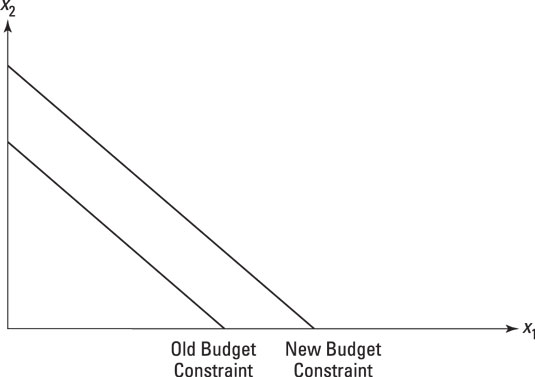### 날짜 : 2024-03-24 15:13
### 주제 : Indifference Curves and Budget Constraints #economics
----
### 4.2 Indifference Curves and Budget Constraints
### Indifference Curves and Budget Constraints
The concepts of indifference curves and budget constraints are essential to understanding how consumers make choices between different combinations of goods and services. These concepts help to graphically represent consumer preferences and the limitations imposed by income and prices.
#### Indifference Curves

An indifference curve represents a set of bundles of two goods that provide the consumer with the same level of utility, which means the consumer is indifferent between them. Here are key characteristics of indifference curves:
1. **Downward Sloping**: Since you have to give up some of one good to get more of another while staying at the same utility level, indifference curves slope downwards.
2. **Higher Curves Represent Higher Utility**: A curve that lies further from the origin reflects a higher utility level because it consists of bundles with more of at least one of the goods.
3. **Never Cross**: Indifference curves cannot cross because that would imply inconsistent preferences.
4. **Bowed Inward**: This shape reflects the principle of diminishing marginal rate of substitution (MRS), meaning as you consume more of one good, you are willing to give up less of the other good to keep the same level of utility.
#### Budget Constraints
A budget constraint represents all combinations of goods that a consumer can afford given their income and the prices of goods. Graphically, it's a straight line where:

1. **The Slope**: The slope is determined by the relative prices of the two goods.
2. **Intercepts**: The intercepts on the axes represent the maximum quantity of each good that can be purchased with the available budget.
3. **Income Changes**: A change in income shifts the budget line inward (decrease in income) or outward (increase in income) without changing the slope.

4. **Price Changes**: A change in the price of a good rotates the budget line around the axis intercept of the other good.

#### Bringing Indifference Curves and Budget Constraints Together
Optimal consumption occurs at the point where the highest attainable indifference curve is tangent to the budget constraint. This point of tangency indicates the best possible combination of two goods that maximizes utility given the consumer's income and the prices of the goods.
### Examples of Indifference Curves and Budget Constraints
#### Example 1: Choosing Between Movies and Concerts
Suppose you enjoy both movies and concerts, and you have a fixed entertainment budget. Let's say a movie ticket costs $10 and a concert ticket costs $50. Your budget constraint will show how many of each ticket you can afford.
Now, imagine your indifference curves show that you're equally satisfied with 4 movies and no concerts as you are with 1 concert and no movies. If you had 5 such indifference curve options, each would represent a different level of utility, but within each curve, you're indifferent to the combination of concerts and movies.
If there's one combination that sits just where the highest indifference curve you can reach touches your budget line, that's the optimal combination of movies and concerts for you given your budget.
#### Example 2: Coffee and Croissant
Consider that you have a budget of $10 for your morning snack. A coffee costs $2 and a croissant costs $4. Your budget line will show you can afford either 5 coffees, 2.5 croissants, or a combination of the two.
Your indifference curves might show different combinations of coffee and croissants that give you the same satisfaction. For instance, you might be equally happy with 3 coffees and 1 croissant, or with 1 coffee and 2 croissants.
The optimal choice will be where the budget line is tangent to the highest indifference curve, which might be at 2 coffees and 1 croissant.
### Practice Task: Drawing the Concepts
A helpful study exercise would be to draw these concepts. Take a sheet of graph paper and sketch:
1. A budget line based on an example budget and prices.
2. Several indifference curves representing different utility levels.
3. Find the optimal consumption bundle by illustrating the tangency between the highest reachable indifference curve and the budget constraint.
Remember, the combination at which the budget constraint and the highest attainable indifference curve touch tangentially will give you the quantities of both goods that the consumer should choose to maximize utility. Understanding how changes in income and price alter the budget constraint and, subsequently, affect the consumer's choice is crucial to predicting how changes in economic conditions can impact consumer behavior.